It’s quite remarkable how differently people spend on a 12 month gap year or RTW (Round The World Trip) We spent just $30, 000 for our family. That’s under $10,000 each for the year. That was in Australian dollars but at that time $ Au and $ US were very similar. Others spend $30,000 per person just for one year of travel. I’ve even come across one spend of close to $40,000, for one person. I decided to find out why. What’s expensive, and what’s cheap, how are some people taking a gap year on a small budget, and how are others blowing money on an expensive trip? What does, or should, your gap year or round the world trip actually cost and is an average gap year cost really any indicator at all?
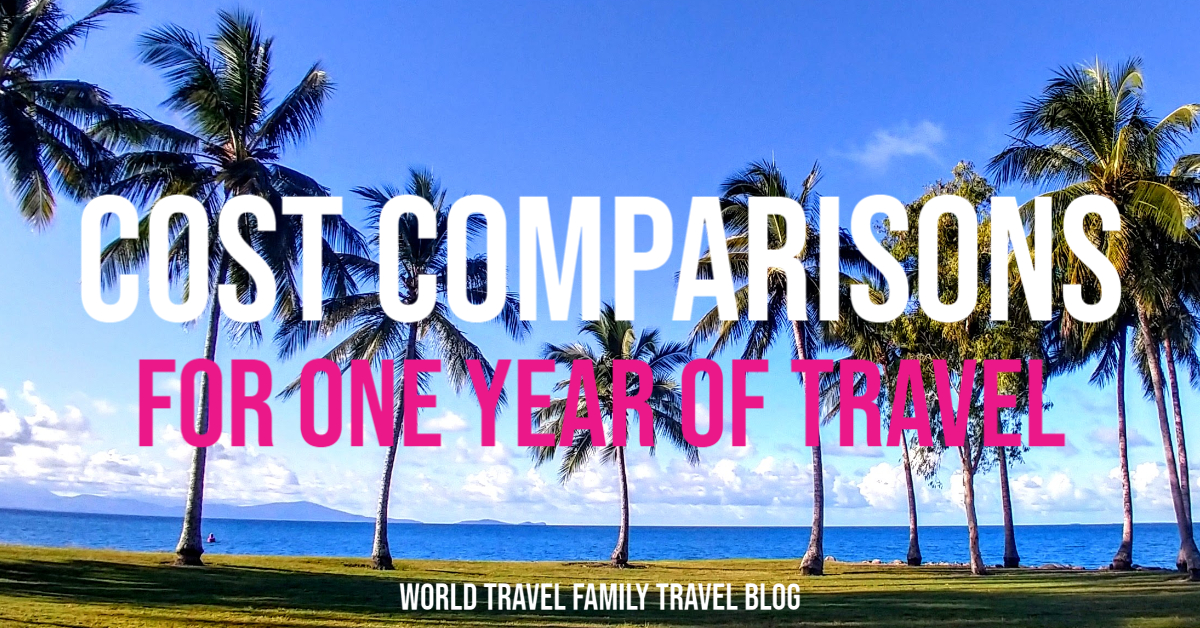
Gap Year Costs
Gap year costs vary enormously. Expect to pay between $5,000 and $40,000 per person depending on travel style, single, couple, or family, destinations, and activities. Our post looks at average gap year costs, expensive, and cheap gap year expenses. Our first gap year cost us a very modest $30,000 for four people. We look at factors affecting gap year cost below.
Average Gap Year Costs
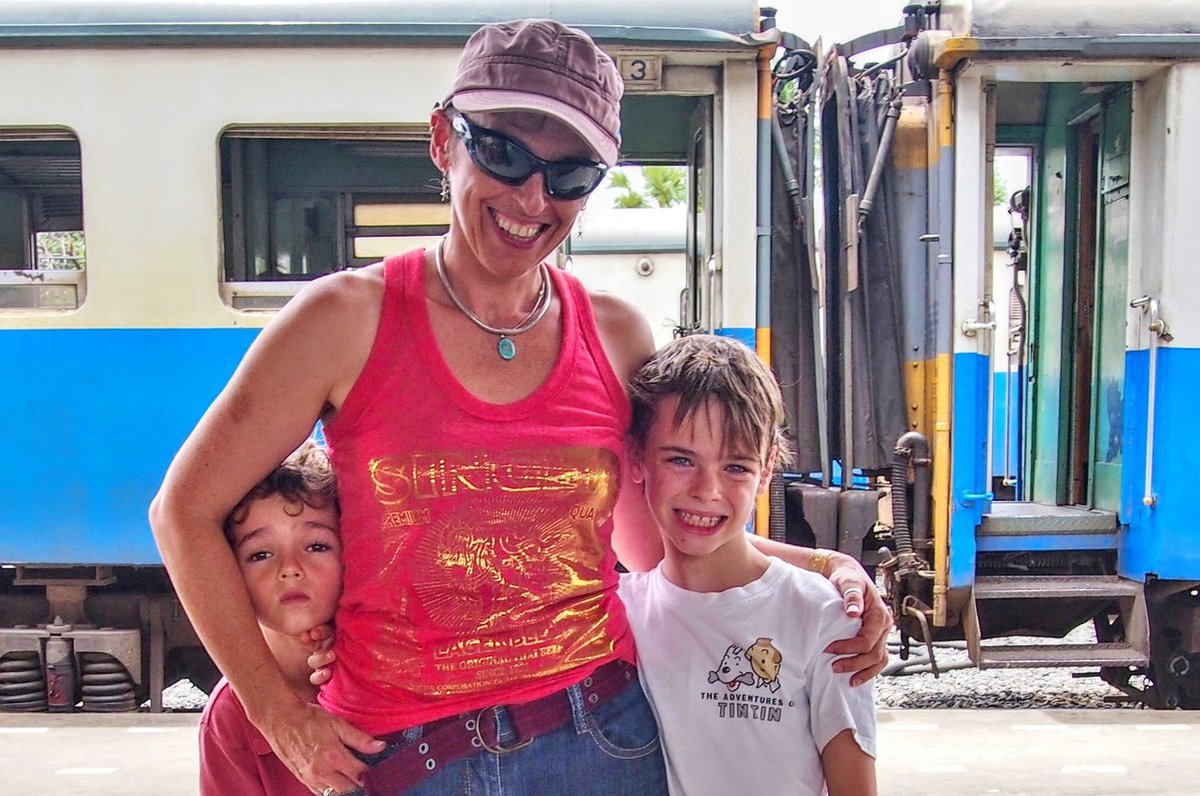
The average comes in at around $20,000 per person per year for 12 months of travel based on a broad selection of bloggers including those below. That’s a lot more than we spent and not as high as the $30K Google likes to give as a typical cost. I’m going to look into why.
| Website | Total | Travellers | Cost /Person |
| A Little Adrift | $17,985 | 1 | $17,985 |
| World Travel Family Travel Blog (us) | $30,000 | 4 | $7,500 |
| Hole in the Donut | $38,221.62 | 1 | $38,221.62 |
| Love and Road | $17,515 | 2 | $8,757 |
| The Professional Hobo | $27,611.00 | 1 | $27,611.00 |
I found much cost data at Livi With Less, but the list of 50 costs there included figures that were guesses, estimates, and supposed typical costs put out by travel companies. These are always high to encourage you to buy RTW tickets and so on. The costs above are real costs of one year of travel only.
None of the blog posts I read outlining year-long spending claimed to spend extravagantly. Everyone was watching their budgets. It just goes to show that you can’t give typical costs, ever. One person’s budget travel is another person’s high-cost trip.
Destinations Will Dramatically Affect Costs Of Your Gap Year
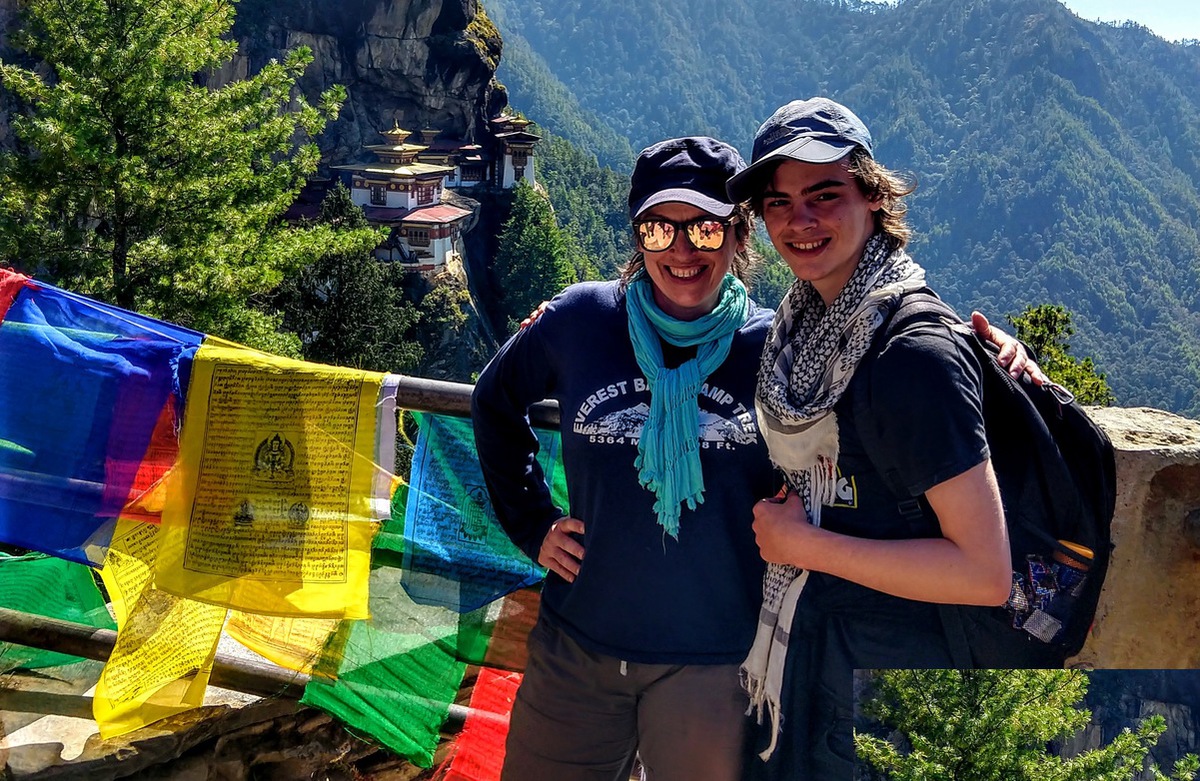
If you mostly travel in the cheaper parts of Southeast Asia, you could spend a year travelling at well under $10,000 each, I think. Our budget for Southeast Asia was under $50 per day, that would have come in at around $15,000 for four people for a year in the region. Two of our people were fairly small children, so obviously, they cost less, but only a little less.
There are small discounts on flights for kids under 12 years old, occasionally they can travel free on buses if they sit on laps, and “kids stay free” deals in some hotels will save you cash.
I felt that we spent fairly extravagantly, we always eat in restaurants, we very rarely self-cater and we have a couple of beers on most days. House-sitting and Couch Surfing were not for us. We tried house-sitting and really disliked it, so that was a one off. We do look for budget hotels but with kids, we can’t stay in a hovel. Let’s look at the expensive destinations and where to avoid if you want to keep the costs of your gap year down.
In our estimation, based on personal experience, these are the more expensive places to travel, or not.
- Bhutan, Bhutan has a set daily fee of $250 each, it’s government policy. There are sometimes variations and exceptions for certain nationalities.
- Australia
- New Zealand
- London
- Scotland
- Switzerland
- Most big cities or up-market resort towns in Western Europe
- Singapore
- New York
- Washington
- Most paradise islands in the Pacific
- African safaris
- The Galapagos Islands
- Easter Island
- Maldives, we added this destination to a trip to Sri Lanka, so the total extra price tag wasn’t too painful.
- Anywhere remote with high flight costs
- South America isn’t cheap. This isn’t our area of expertise, we’ve only been to Peru.
- Trekking in Nepal, even on a tight budget, costs add up fast
Friends of ours, Amy and Andrew, keep fantastic records of their travel costs, by destination. Check out their travel costs for a couple.
Activities Will Increase Your Gap Year Budget
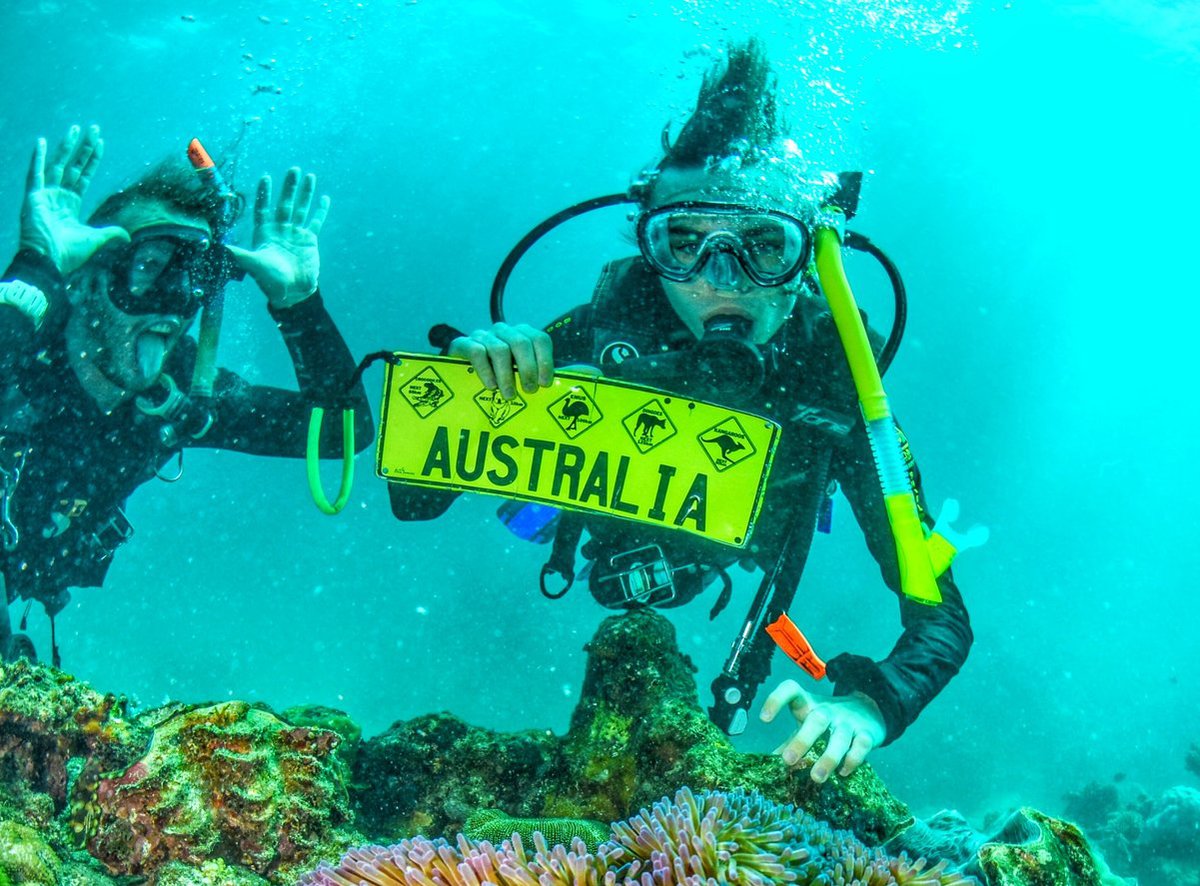
Certain activities cost you nothing, others have a hefty price tag. Luckily, we enjoy walking and looking, soaking up a new country just by being there. But if you travel as many holidaymakers do, to visit particular attractions, theme parks, water parks and so on, you’ll spend a lot.
You’re likely to spend a lot if you want to ski too, again, location is important. We spent several winters skiing in Romania where costs are tiny compared to the popular European ski resorts or Australia. Bulgaria is also a cheap place to ski and in Western Europe, check out Andorra.
Activities that will increase your RTW budget include the following.
- Scuba diving, but obviously this is cheaper in, for instance, Thailand than Australia.
- Skiing and snowboarding.
- Visiting the Great Barrier Reef, this is massively expensive, we live in North Queensland, we know. We go a lot, but mostly we don’t pay.
- Safaris
- Helicopter Rides
- Visiting theme parks – unless you’re a travel blogger, this has mostly been free for us.
- Visiting every cultural or historical attraction with a high price tag (looking at you Sri Lanka.)
If your year off, gap year or round the world trip is about ticking off every dream destination and price isn’t an issue at all, go for gold. If you’ve got it, spend it. I’m absolutely certain I could easily spend $40,000 in a year if I wasn’t thinking about value for money. But let’s have a look at what the big budget gap year travellers did and how they spent.
Flights and Transport Costs Will Affect Gap Year Price
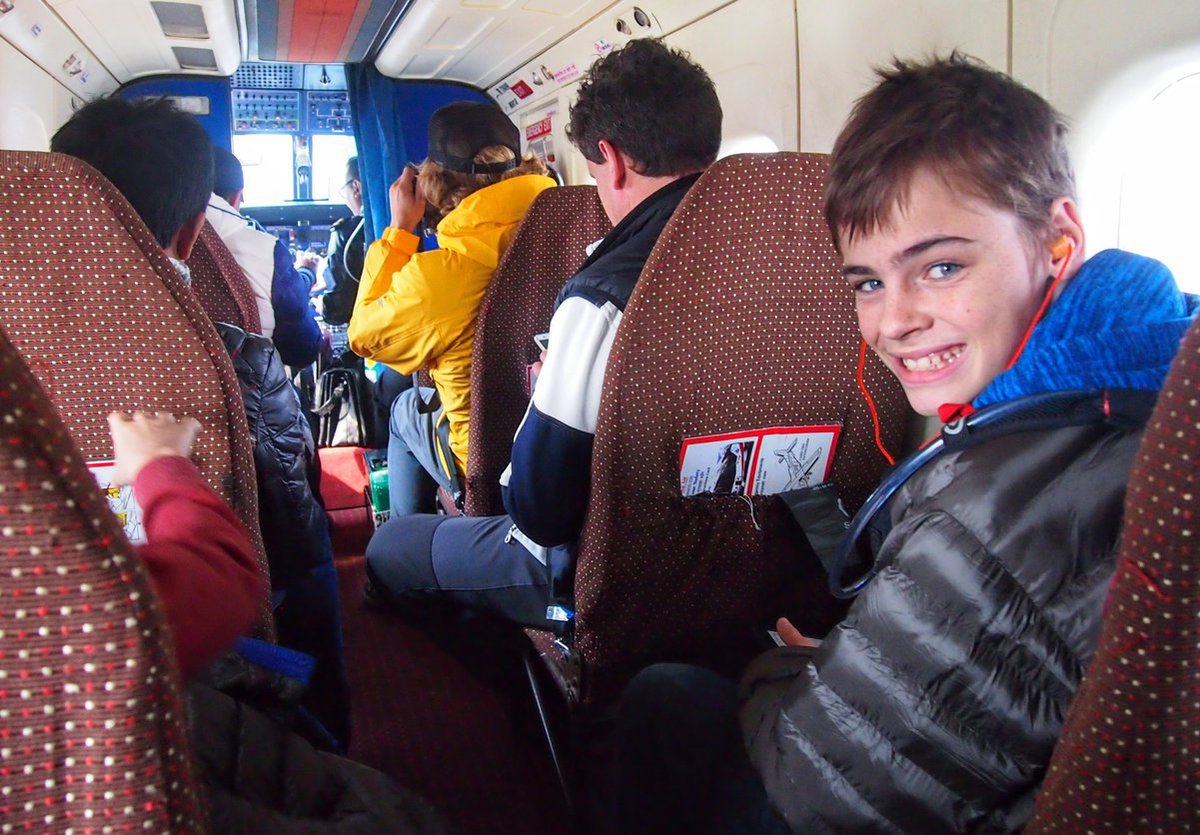
If you’re fortunate enough to live in a place with cheap flight connections and choose not to visit the countries with expensive, long-haul flight necessities, you’re going to spend less. Skipping across the Atlantic or Pacific on a plane, flying to most of Africa, or any flights to the east coast of Australia are going to cost you a lot. Anywhere remote is expensive. Travelling around Asia and Europe or even some of the Americas, is fairly cheap by comparison.
The number and length of flights you take, the distance you travel, will dramatically affect your costs and your carbon footprint. Does an RTW truly have to be “round the world?” Should you actually circumnavigate the globe? We don’t think so.
To us, it makes sense to pick the most cost-effective and eco-friendly way to link your preferred destinations together. We opt not to buy RTW plane tickets. We have bought them in the past, but we think you can do better by piecing together a better route. Look into this yourself, get a price on RTW tickets then check our Skyscanner post for ways to find cheap flights by reverse engineering your route. This is a big part of how we go about planning a world trip.
You can get reasonable flights between Australia and Asia from Darwin or Perth and flights into North Africa, Morocco, Egypt and so on, aren’t so bad from Europe. Always check your cheapest routes by using our Skyscanner tips above.
Single, Couple or Family, Which is Cheapest?

From the table of costs we can see that single travellers spend a lot more and this is totally understandable. Single person supplements on rooms must add up fast and if I were travelling solo, I’d take fewer risks. (I’m due to set off to travel solo very soon, as an over 50 female traveller.)
I’d be looking for security, better accommodation, tours and guides. With my husband by my side, I’ll go anywhere but as a solo woman, I’d be cautious.
Kids obviously cost less, but unless they’re under two years old, flights don’t cost much less. Accommodation cost comes down with kids-stay-free deals but you’ll usually be sharing beds. That worked out fine for us when the kids were younger. Now I travel with teens and my older son and I do usually share a room, but sharing beds rarely happens now unless it’s a dire emergency.
Now, with two teens we’re basically paying for four adults. Two twin rooms and a room for four generally costs about the same. This is why couple travel and family travel are more equivalent than single travel.
How Did The Most Expensive Gap Year, Get That Expensive?
Hole in The Donut, a single female traveller, spent a staggering $39,000 in one year. Let’s look at what she did. She excludes a lot of her expenses from this total, such as clothing and electrical goods. We include those and in our year we bought two new laptops. She says she stays in private rooms in hostels with en-suite, that’s not a massively expensive option.
She does break down her spend beautifully and exactly here. She obviously kept complete records. She spent the same, more, for one person than we spent for a family of four.
Unfortunately we didn’t keep exact records, we just know that we started with $30 K and that we spent all of it in a year, roughly $100 per day, but our spend does include everything for four people ( two kids).
Everything looks pretty OK on Hole in The Donut’s spend break-down. $16 K on accommodation, that’s just $43 per night which seems reasonable. Single rooms do tend to be expensive.
We rarely spend above $50 per night on accommodation for all four of us. We were super careful in year one, these days we’re, kinda wealthy, but still we keep accommodation costs low. I doubt that even today we’d spend that much for the four of us.
In much of Southeast Asia we were able to spend under $20 per night. Unfortunately, I can’t give you a daily average. In the US we mostly spent $40-$50 for motel and hotel rooms for four. In New York and Washington, we spent over $100. In that year we did have a few free stays with friends and family but no sponsored (free) hotel stays and certainly no CouchSurfing or HouseSitting.
This lady spent $10,000 on flights and other transport, in one year and $5,000 on food. So $13 a day on food, that’s very modest. We rarely get away with $13 for the four of us for dinner.
Our food spend would have been higher, most certainly. We almost never self-cater, I’ve never used a hostel kitchen in my life.
She spent just over $1000 on visas, that’s a huge visa bill, That’s a lot, but India cost us over $100 each and was our most expensive visa bill ever. I think that’s a lot of visas, a lot of countries and expensive airlines.
Unfortunately Hole in The Donut doesn’t tell us where she went in that year. I’d love to know.
In our first year we spent approximately $5000 to $6000 on flights, cruise ships, and other transport for four people. Our most expensive flight was from Australia to Kuala Lumpur, that was about $800 for four of us.
Our two Atlantic cruise crossings came in at $1,200 for four people, including all food and accommodation for 10 days each time.
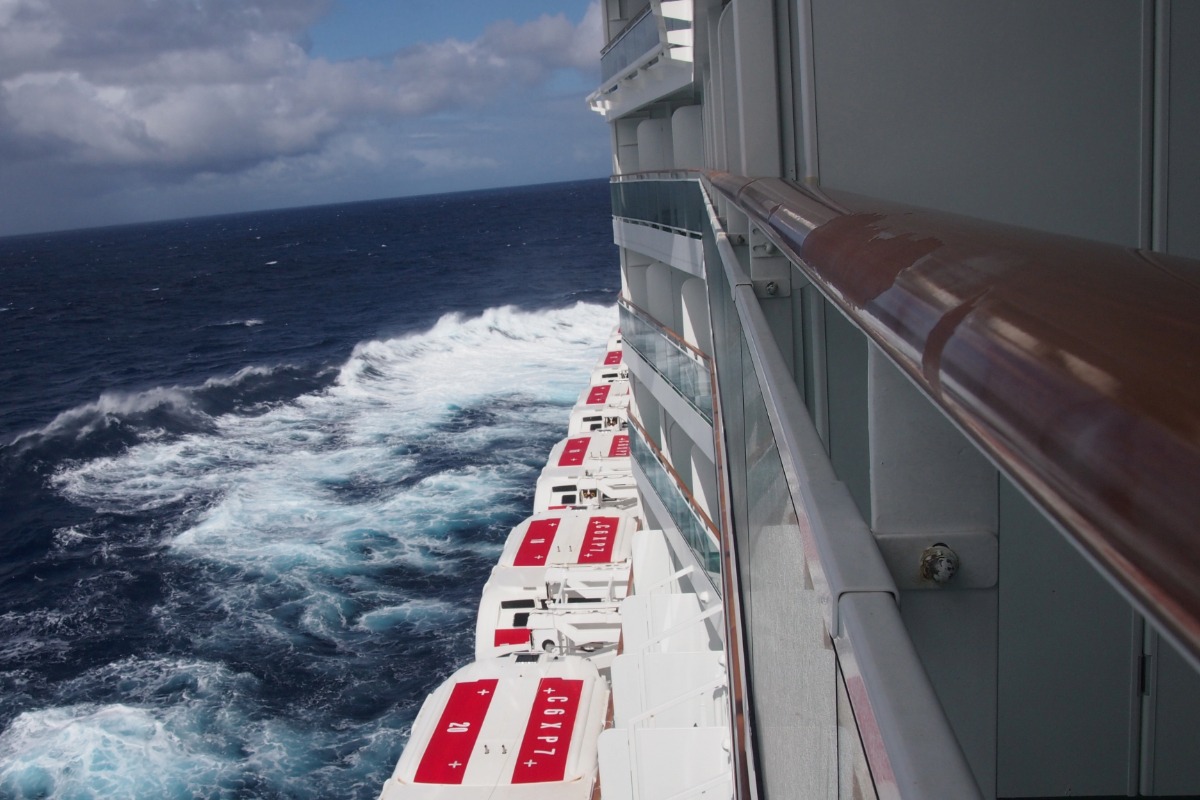
We travelled from Australia to Southeast Asia, to Sri Lanka, the UK, USA and Central America, before returning to Spain by ship, then the UK.
Hole in the Donut’s cost is for 2017, our costs are for 2013, but Chef and I think that travel has actually become cheaper over the years. In the destinations we visit often we have been able to directly compare. Obviously currency fluctuations affect costs too.
Hole in The Donut gives costs for admissions at almost $1000. This lady is a big blogger, she must have had a lot of free admissions. I don’t know if here she’s giving what she actually paid, or what she would have paid.
In our first year on the road we had free admissions for Disney and Legoland parks, we don’t include these costs because nothing came out of our bank account.
We actively avoided paying admissions for some big sites. Admission costs in Sri Lanka were steep, we skipped them. This was the second and third time for Chef and me in Sri Lanka, we got married there, so we’d already been to most of the historic sites. We knew we’d be back to show the kids these places and they’d get more out of them when they were older, so in year one we skipped them and just hung out instead.
There’s nothing really jumping out at me in Hole in The Donut’s $39K for one compared to our $30K for four as being a huge difference, she spent more on flights and visas, probably more on accommodation, but her costs do look pretty reasonable. She must have spent a lot more in total, a lot of her expenses aren’t included and these extras really added up for us.
Obviously you really can’t give a fair per person price when two of the persons were quite small children (six to nine years old), but flights are not significantly cheaper for kids. Food costs less, they don’t drink beer and you can shoe-horn them into hotel rooms. A fair comparison is impossible.
Hole in The Donut says she spends modestly, so do we. It’s really interesting how these figures come together.
The Second Most Expensive Round The World Trip
The Professional Hobo was the second most expensive year of travel on the list with a 2018 spend of over $27,000. Again, The Professional Hobo is a solo female traveller and I’d always expect solo travel to be more expensive than couple or family travel unless the traveller enjoys staying in hostel dorms.
This lady moved between Australia, Asia, Europe and the Americas in this year. She stayed for free and flew business class along with having a major medical bill in Thailand.
There is nothing surprising about this spend, she spent big and she spent small. The only picture emerging from all of these travellers’ spending reports is that everyone spends differently. We could all do it cheaper if we wanted to.
The Cheapest Round The World Trip
Congratulations to Road Is Calling for spending under $5000 per person for a young couple. That’s cheap, and no child costs or single person supplements to skew per person costs here, just two adults.
These guys spent a lot of time (approximately four months) exploring North America, this is where they started, so no big flights there. Then they hopped on a plane to Germany to explore some of Europe, later they carried on to Southeast Asia. They didn’t go to Australia, Singapore, Switzerland, Japan, none of the more expensive countries.
These guys must have absolutely smashed their costs by Couchsurfing, it looks like they did this a lot. We’ve never Couchsurfed as a family and I doubt a solo female traveller would be too keen on this option either. We host Couchsufers, and all of our guests have been couples or pairs of friends.
Road is Calling prefer overland travel, as do we, and visited similar countries, 19 in total. They did more slow travel than we did in our first year. I’m actually surprised they spent that much given how low their hotel bill was, just $1,651, that’s $4 per night.
They only spent around $2000 on flights, that’s impressive, total transport costs coming in at under $4000 for two.
Their total spend for the whole year was just under $10,000. Our first RTW as a young couple, 20 years ago, was 10,000 UK pounds. We included Australia and The Trans Siberian Express, both were expensive. We also bought Round The World tickets. The internet was in its infancy back then and budget airlines didn’t exist. Again, we think travel costs have come down over the years.
Is Travel Really Expensive?
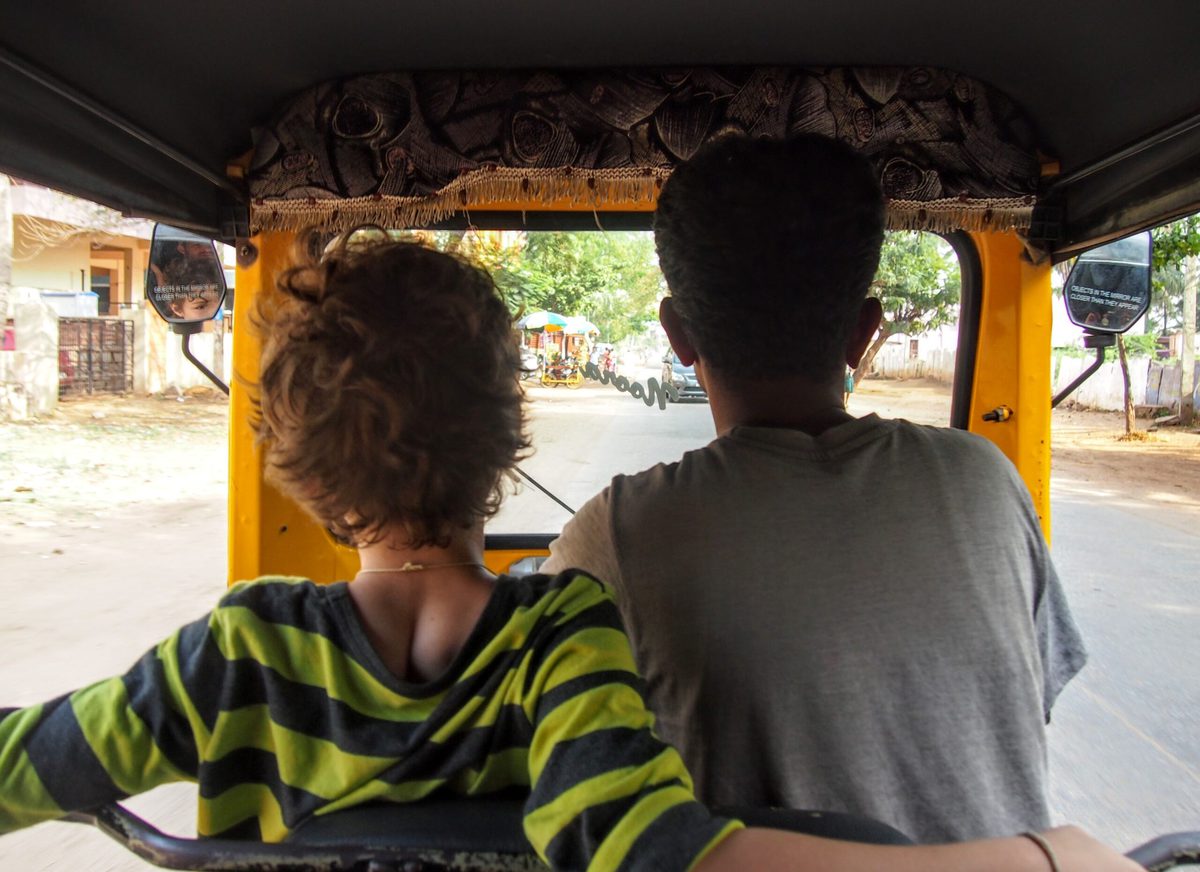
Some of you will be looking at these figures and inwardly shrieking at the thought of blowing somewhere in the region of $30,000 on a holiday. But that’s not what it is.
When you go on holiday or vacation you are still paying your at-home costs. These costs will include mortgage, rent, car loans, utilities, taxes, and so on. Those of us who travel full-time, and most of the bloggers above are digital nomads of some kind, we have no at-home costs.
Think about your salary. Lets assume you spend all of it in any given year and don’t squirrel it away into savings. Is it more that $10,000, $20,000, $30,000? I know our family’s annual income, and cost of living in a house we owned, was way, way higher than our travel costs.
Travel is cheaper than staying at home but of course, most of us can’t earn while we travel. That’s not the case for the digital nomads, we found ways to earn a location independent income.
We earn as we travel, as we spend on travel and right there is the key to freedom.
Conclusion
If you’re looking for more information on planning and executing a gap year or round the world (RTW) trip, we have a post on your Family Gap Year, as well as one on How To Travel For Free, these would be great starting points. We also cover 50+ travel destinations on our website. We travelled full time for several years with our children and previously took a 12 month RTW as a young couple.
I started putting this post together because I was intrigued by how much costs varied. I thought I might be able to find a pattern or be able to spot how traveller a spends so much while traveller b‘s costs are modest. It doesn’t look like there is a defined pattern. Everyone travels so differently and circumstances vary so much that it’s hard to make fair comparisons. What’s certain is that all of these travellers had fun. Everyone enjoyed themselves and got out to see the world. They all found and enjoyed freedom and really, that’s all that matters. Travel your way, no way is wrong, no way is right, spend what you have and enjoy the ride. Tell us in the comments how much you like to spend or how budget you can get when you travel? Please use the Pinterest button below to save and share, thanks.
If you'd like to hire a car during your stay, use this car rental comparison tool to find the best deal!
We also suggest you take a look at this company to get a quote for all kinds of the more tricky adventure or extended travel insurance.
Try Stayz / VRBO for an alternative way to find rentals on homes/apartments/condos in any country!




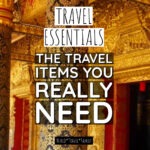


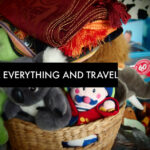

Hello Alyson,
Great read. I am always fascinated by RTW travel numbers. I tracked so many articles when we were preparing for our trip. I love reading about others travel.
We traveled for one year in 2017-2018 and kept track of every single coin by using Trail Wallet app. We were keeping to a budget of $140 a day for a family of four (two boys 10, 8 at the time). We did pretty good although some of the flights got us. So, the average is a bit more overall.
We travelled from Portland, Oregon, US (via Hawaii), to Australia (one month), SE Asia for about five months, then to Europe for six months. Then back to the US via NY then to West coast. During our time in Europe we paid for accommodation a total of 11 nights in about 170 days (in full disclosure my in-laws met us in Norway and paid for Airbnbs for six additional nights).
We did A LOT Of house/pet sitting especially in Europe and I called on all my friends in a plea for housing (I used to live in the UK and NL) and many graciously hosted us for some days or a week here or there. My husband is a chef and we would ‘pay’ with meals when appropriate. Many of our sits included a car for use for free (thanks so much, still so grateful!!).
We also did a few more expensive things in some of the European capitals on what we called ‘tourist days’ e.g. Eiffel Tower, London Eye, which I don’t regret even though our budget was squeezed on those days. Other days we world schooled at ‘home’, wandered around quiet rural areas for free and our costs were very low.
I still talk about how it was cheaper to be ‘on the road’ than to be back home due to the lower costs of having to carry everything you own and not having all those monthly costs of being stationary.
Thanks for writing this. I have been shy about writing ours all out and maybe now I can. Thanks again for sharing Alyson.
No worries, thanks for contributing your expenses and costs. I love the London Eye, I’ve been on maybe 4 times, yes, it’s very expensive, but last time, as bloggers, we finally got London Eye tickets for free, along with The Shard. If I had to pick one splurge item in London it would be The Eye, so long as I can have London Zoo too.
Great post, it’s fascinating to see how much different people spend on their travels, it really does vary depending on where you go, how you like to travel and who you travel with. We do try to travel on a budget most of the time (mainly because we usually don’t have much cash!) but have definitely spent more on ‘dream’ trips like our road trips in New England and California, plus trips to Australia and New Zealand.
If we’re working along the way we tend to spend more on nicer accommodation with good wifi and some sort of kitchen. When we next travel it’ll be back to SouthEast Asia and I’m actually really looking forward to going pretty budget again, travelling overland and staying in cheap but decent places along the way. Can’t wait to get out there again! It’ll be interesting to see how Covid has affected travel costs too.
Yep, the budget travel way is still my absolute favourite way to go. I’m a backpacker, always been a backpacker, I just have no interest in fancy hotels really. We do stuff like that sometimes for a bit of variation but I’m happiest in the guest houses of Southeast Asia and India, Nepal, the old backpacker trail.
Interesting article! Trying to budget for our family of 4 to do 3+ months Europe travel mostly by train when we can. Any hunches about whether airline travel from Australia will get cheaper or more expensive when the covid crisis is over? I know its impossible to know for sure but just wondered what you think.
I think there will be very few flights and they’ll be super expensive. The Australian government doesn’t want Australians leaving and spending their money anywhere else. Unless Air Asia comes to our rescue. They’ll get you to KL from some of the southern Australian airports. They’ve got to open the international borders soon, this is crazy.
Hi Alyson, really interesting post, thank you! Always fascinated to read how much/little others spend (especially when they describe their travel style as budget/modest). Am sure we could all burn through a lot more if we didn’t have any restrictions or trade offs to make! When I translate these budgets from what I assume is US dollars to Australian, I’m gobsmacked by Hole in the Donut – $57,000/$156 per day – gulp. Pre Covid my daughter and I were making several shorter trips each year (3-7 weeks each) and even in Europe weren’t spending this much each per day. 4w in SepOct was $85pppd but included flights from Australia, hotels in Vienna and London, theatre in London etc which were all expensive compared with hotel costs in Budapest or Montenegro. In Asia we’re probably spending this per day in total rather than each. And if we were 12m travellers, this would come down again. I now keep detailed records of our spend, which helps fine tune where we can save on future travels, and estimate what we would need should we have the opportunity to travel for a full year.
Hi there, Isn’t it just so interesting? I’m not trying to attack anyone, not at all, I just find this absolutely fascinating. We are a family that loves to eat and drink. We eat so well. And still, we spend small. Thanks so much for your comment, we love comments. Best of luck to you and your daughter.
In the past 5 years I’ve spent a lot of time looking at ways to save money on travel, without compromising on the experience. Our last two trips to Europe, we went where the good deals were – when one way flights to Austria from Australia on a full service airline are under $400, and flights from Hungary to Albania are $6 (!) it’s a great way to see the world for less. If you’re enjoying how you’re travelling, whether that be in a hostel or apartment, seeing sights or hanging out, then that’s what’s important, not how many $ you spend or save. I remember as a teenager travelling in Indonesia and meeting European backpackers who were miserable (and hungry) because they were determined to stay away 12 months. They saw none of the sights, didn’t attend any cultural performances, and are only basic rice or noodles. I thought that was such a wasted opportunity!
They were having fun and knew they’d be able to go back any time if there was stuff they still wanted to do. I’d take being a penny-pinching backpacker in Southeast Asia over having to go to work every day in a heartbeat. Luckily I haven’t had to go to work and be a wage slave in the last 15 years. That lifestyle is just priceless, still, to this day, it’s my favourite way to be and to live. Once tasted it’s hard to put out of your mind.
Really enjoyed reading this post. A very interesting read
Thank you Leezett. Any idea how much you typically spend?